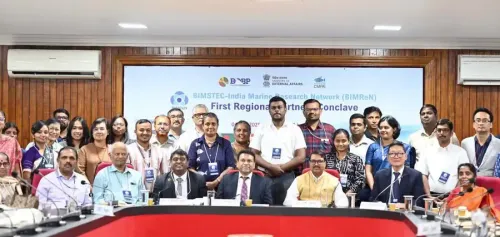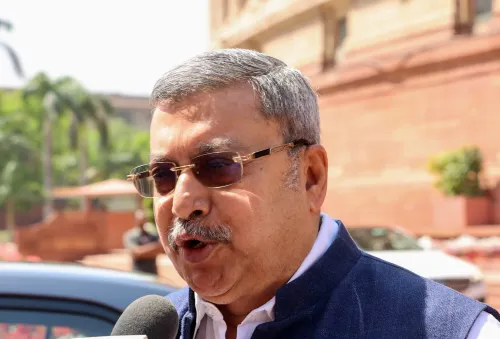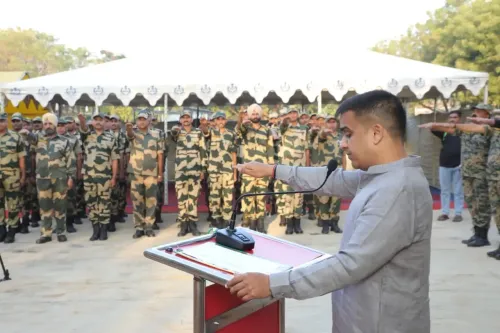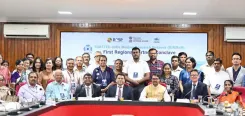How is India's Engagement in South Asia Promoting Collective Growth?

Synopsis
Key Takeaways
- India's 'Neighbourhood First Policy' emphasizes regional cooperation.
- Infrastructure projects in Sri Lanka and Maldives showcase India's commitment.
- Emergency economic assistance during crises highlights India's solidarity.
- Partnerships with Nepal and Bangladesh enhance energy and trade.
- India's humanitarian aid extends even to conflict-affected regions like Afghanistan.
New Delhi, July 29 (NationPress) India's involvement in South Asia, guided by Prime Minister Narendra Modi's "Neighbourhood First Policy, highlights not only geographical closeness but a profound dedication to mutual regional development, according to a report released on Tuesday.
"The prosperity of a neighbour is crucial for the stability of the region. This steadfast belief has consistently shaped India's strategy towards its closest allies," the Asian News Post report noted.
As per the report, India has significantly contributed to infrastructure in Sri Lanka, upgrading railway stations and tracks, which has restored public confidence and boosted freight movement from Colombo to Jaffna, thereby enhancing the lives of many in the island nation.
"Moreover, during Sri Lanka's financial crisis, India extended emergency economic support, including multi-billion dollar Lines of Credit for vital supplies such as fuel and fertilizers, proving that true friendship is evident during both prosperous and challenging times," the report elaborated.
In Maldives, the Greater Male Connectivity Project—India's most extensive infrastructure initiative in the nation—is revolutionizing interactions among communities and markets throughout the archipelago, as noted in the report.
Furthermore, during the Covid-19 pandemic, India displayed significant humanitarian support in the Maldives, dispatching naval ships and aircraft to deliver vaccines, ventilators, and other medical supplies when the healthcare system was overwhelmed.
Nepal, sharing profound geographical, cultural, and economic ties with India, has also seen advancements. The Motihari-Amlekhgunj petroleum pipeline—the first transnational oil pipeline in South Asia—has ushered in a new era of fuel security.
"Additionally, integrated check posts, cross-border rail systems, and power-sharing agreements are instrumental in enhancing cooperation. Following the devastating earthquake in 2015, India’s swift reconstruction efforts helped restore thousands of homes and historical sites in the affected districts of Nepal," the report indicated.
Conversely, ties with Bangladesh have strengthened through collaborative infrastructure projects and cultural engagements. The Maitree Thermal Power Plant at Rampal, a joint venture between the two nations, alongside initiatives to rejuvenate inland waterways, has bolstered energy and trade partnerships.
India is also expanding its influence eastward with Myanmar, undertaking projects like the Kaladan Multi-Modal Transit Transport System and the India-Myanmar-Thailand Trilateral Highway, enhancing connectivity between Northeast India and Southeast Asia.
"Despite the political instability in Myanmar, India continues to provide humanitarian support, including food and medical assistance to communities affected by conflict," the report stressed.
In war-torn Afghanistan, India's contributions have made a considerable impact. Initiatives like the Afghan Parliament building in Kabul, the Zaranj-Delaram Highway, and scholarships for Afghan youth are not merely diplomatic gestures, but investments in a future grounded in peace and community.
Emphasizing India's collaborative approach to development, the report mentioned that through the Indian Technical and Economic Cooperation (ITEC) program, thousands of professionals across the region receive training annually in various fields, such as agriculture, governance, disaster management, and public health, thereby fostering a "network of shared expertise".
These efforts illustrate a larger vision where railways, roads, power lines, and educational institutions form the foundation of lasting partnerships in the region.
India's growth is interconnected, as "when neighbours progress together—with compassion, connectivity, and determination—the entire region flourishes".









